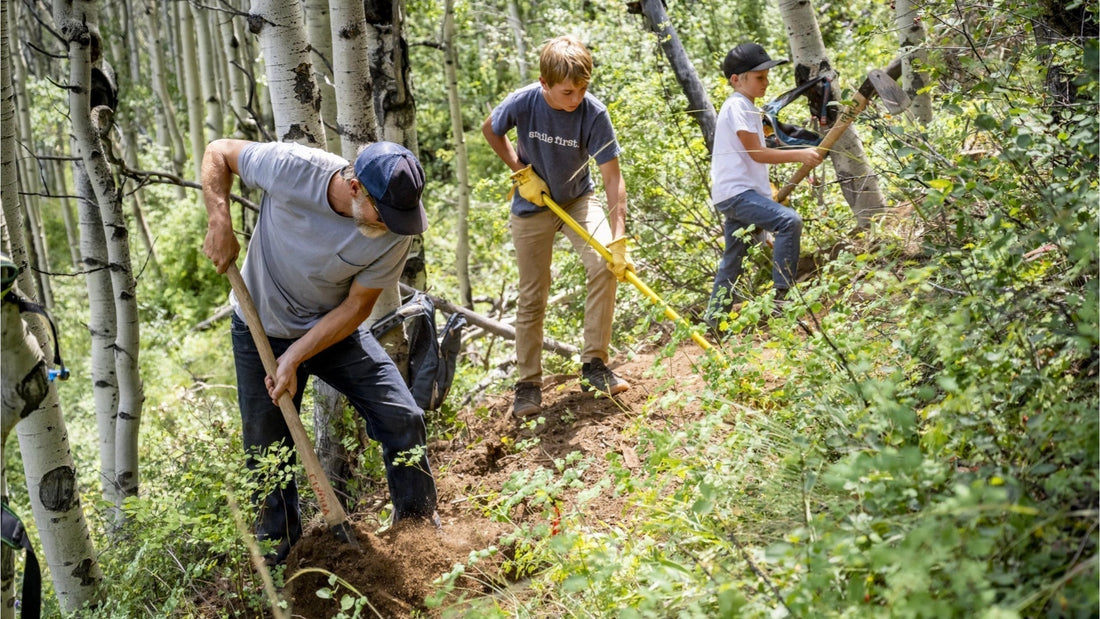
What About Leaving MORE Trace in 2025?
Share
We are huge supporters of Leave No Trace and the Seven Principles. They serve as a set of the most fundamental practices to follow in the wilderness. They enhance our safety by encouraging us to prepare ahead. They urge us to be respectful of all living things be it plant, animal and fungi. And they help to ensure that our presence is felt as little as possible.
And, it's that last part we want to dig into...
A dizzying number of factors threaten our public lands, including climate change, always increasing use (which is a good thing assuming we're equipped to handle it), budget and staffing shortages among land management agencies, including thousands of lay-offs of USFS, NPS and Fish & Wildlife employees, and political pressures to open more public lands for resource extraction, and worse, sell them off entirely. All of this can be very difficult to face, especially amidst the pressures of everyday life.
Through our scramble to protect what is left of our public lands, we have created barriers to accessing them. We limit the number of people who can use them; we control the areas where people can stay; and we require payment to use certain places. These regulations have essential benefits, but they also subtly reinforce a sense that we are separate from nature. This separation works against our inherent connection to nature. And, if we see ourselves as separate from nature, are we less likely to take action to protect it?

Leave MORE Trace was an idea coined by Chris Loynes, a Professor of Human Nature Relations at the University of Cumbria in the UK. It challenges us to ask whether we need to be taking an even more hands-on approach. In his paper on this subject Chris says, “Leaving only footprints and taking only photographs will not make places ‘better’ and leaving most places as they are is not an option either.”
This idea takes on a new urgency with the mass lay-offs of federal employees by the Trump administration in recent weeks including 3,400 U.S. Forest Service, 10% of the total workforce, 1,000 National Parks staff and 400 Fish & Wildlife staff. We will soon begin to see the effects as trails and roads continue to fall into disrepair; trash litters our campgrounds and parks; firefighters are ill-equipped to combat wildfires; parks are difficult to access or closed altogether; search and rescue is less capable of responding to emergencies, and on and on.
So, maybe our goal right now shouldn't be more pristine, seemingly untouched landscapes, but more resilient ones prepared to deal with the impacts of humans and climate change?
But what can we do as individuals? We believe that now more than ever, we need to work for the outdoors rather than just recreate responsibly. Here’s how we plan to Leave More Trace in 2025.
1. Lobby Politicians
‘Likes’ don’t cut it. Send an email. Sign a petition. Make a phone call. Write a letter. Taking some small action is the best remedy for our nightly doom scrolling. Skeptical about the power of these easy, grassroots actions? Read this on the Big Thompson Divide.
Here's the steps for calling your congressional representatives in the House and Senate:
- Go to Congress.gov, type in your zip and get your list of reps
- Call them directly or call this number (202-224-3121) and say their name to be connected to their voicemail.
- Leave a message with your thoughts. Here's some words to get you going...
- Hi. "My name is ____ and I live in ____ and my zip code is _____. I join the majority of Americans who love our public lands and waters. I want Representative _____ to urge the Trump administration to halt work on action plans to dismantle national monuments and other public land protections and policies. These issues are of fundamental importance to me and I will not vote for representatives who do not take clear action to protect public lands. Thank you."
- Repeat often.
2. Do Trail Work
We repeat…do trail work. Land Managers and trail orgs need your help now more than ever, and it goes beyond throwing away your wrappers and packing out your toilet paper. If you love the outdoors, trail work is one of the most meaningful ways you can spend your time. Find a local organization and dedicate a day. One day. You’ll never go back.
3. Sign Up for & Support Races Run by Trail Orgs
The fees generated from races, specifically ones run by local trail organizations are a huge source of revenue to fund ongoing trail projects. It’s another win-win. You have fun and get exercise. Your registration fees go to funding important work in the area. Shameless plug for the Gunnison Growler if you’re into mountain biking and the West Elk Challenge if you’re a trail runner in Colorado. Both are amazing under-the-radar events that fund non-profits.
4. Donate
Don’t have time or the ability to do trail work? We get it. $20 bucks matters when it’s going to a local organization. Find one that aligns with your passions, get on their mailing list and throw them some cash whenever possible. Plus, trail orgs throw great parties, which are opportunities to get more connected to likeminded folks in your community.
The Call-To-Action
Do these things feel small? Yes! That’s the idea. THis summer we're focusing on supporting events, donating funds and product, swinging pickaxes, writing letters while doing everything we can to minimize our actual impact on the outdoors.

Holocaust survivor Victor Frankl famously said, “control the controllables”. What he means is that we should only focus on the aspects of a situation that we have power over, and not to spend a minute worrying about all the things that sit outside of our control. How you spend your time; who and what receives your hard-earned money; where and how you direct your voice all sit within your control.
Leave No Trace is fundamental. But in 2025, it’s the bare minimum. Those of us with the resources, need to switch our thinking beyond how we’re minimizing our impact to how we are maximizing it. It’s now or never.

3 comments
Well said. Thank you !
Thank you. A greatly needed message. This gives helpful information and offers a perspective that is action oriented.
Great advice, thank you for the inspiration to do more and control what is controllable.